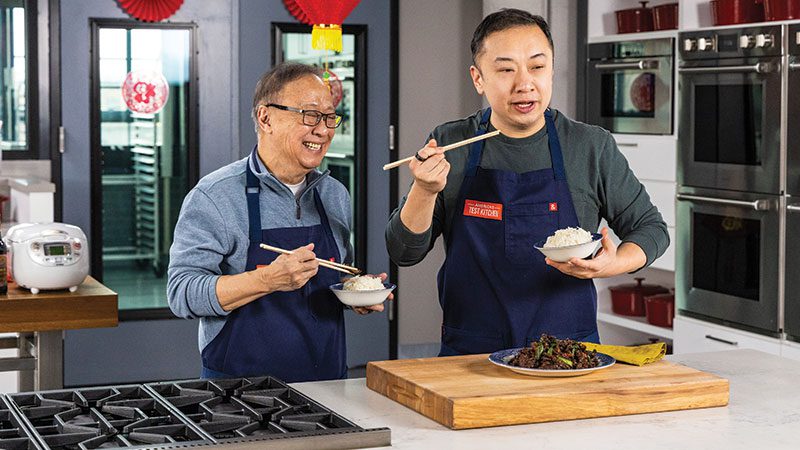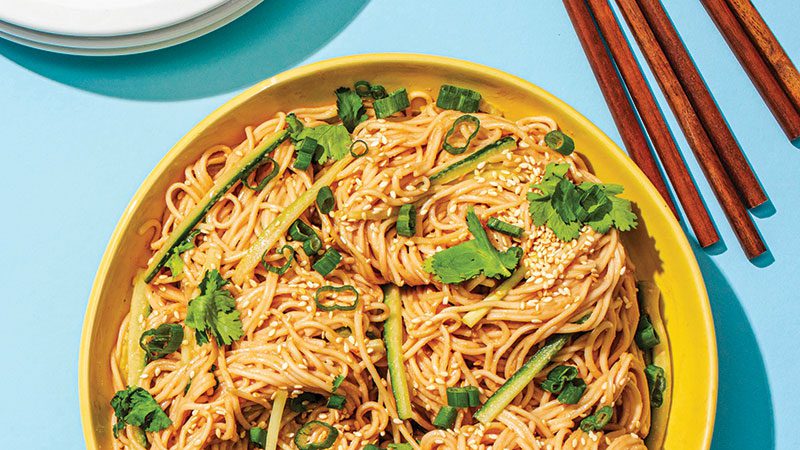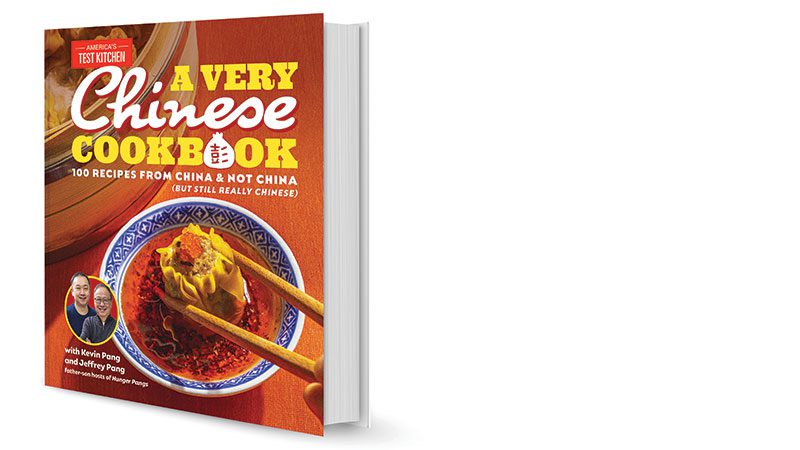A father and son reconnect for “A Very Chinese Cookbook”
By Rebekah Denn
This article was originally published in January 2024

With the help of a good meal, it’s never too late to bring a family together.
That’s what Kevin Pang found when his father forwarded him a video one day. The Chicago writer, currently editorial director of digital at America’s Test Kitchen, had a “cordial and indifferent” relationship with dad Jeffrey then, strained by culture clashes and physical distance.
He opened the file to a close-up of the family kitchen in Seattle, and his mother Catherine’s hands making his grandmother’s recipe for Shanghainese green onion pancakes.
“My virulently anti-technology Chinese parents were starring in their own internet cooking show,” Kevin recounted to an audience at Third Place Books in Lake Forest Park recently. One video turned into a few dozen. “And now, somehow, my retired then-65-year-old father has nearly a million views on his YouTube channel,” he continued, reading from the new cookbook collaboration seeded in that moment, “A Very Chinese Cookbook” (America’s Test Kitchen, $35), available at all PCC stores. They also star in a father-son cooking show, called Hunger Pangs, on making great Chinese food at home.
In the book, father and son share 100 recipes, from simple fried rice to scratch-made Shanghai soup dumplings, all stamped with approval from America’s Test Kitchen’s notoriously rigorous recipe testers. (Typical ATK recipes cost $11,000 each to develop, Kevin Pang said. Even the well-established family hits included in the book went through that process; the soup dumpling tester alone fine-tuned the details by making 251 dumplings in more than 30 batches.)
The recipes are delicious and doable, but the family story adds a lot to the book’s magic. Magic being somewhat literal for Kevin Pang, who worked in the Market Magic Shop at Seattle’s Pike Place Market as a card-trick-obsessed teen.
His family moved from Hong Kong to the Pacific Northwest when he was six, settling in Kent, where he wrote he was “raised as an American during the day and Chinese after school.” Endless arguments with his father were fueled by those differences—not to mention their similarities. But when Kevin switched from the news desk to the food beat at The Chicago Tribune as an adult, they finally had a common passion.
“I had no experience, but I did have one advantage: I was Cantonese. We Cantonese have a love of eating that borders on mania,” Kevin wrote.
The YouTube videos years later started out as Jeffrey Pang’s way of preserving family recipes, as some from older generations had been lost to time before he and his wife thought to ask for them, Jeffrey told the Third Place crowd. A retired businessman, he had always loved to cook and teach; the book even shows a photo of him teaching cooking classes at Kent Commons in 2001.
In one sense, though, the project started even earlier: in the yearlong gap between the family learning they would leave Hong Kong and the day they actually left.
“This was pre-internet, this was pre-Food Network, there weren’t really a lot of cooking shows or cookbooks” showing Cantonese recipes, Kevin Pang said. Even a long distance call lengthy enough to share a recipe would have cost a fortune back then. So his parents “furiously jotted down every single recipe that they had from their childhood, inside this blue notebook.”
The recipes weren’t specific, in the way such family treasures usually aren’t. “Add a little of this.” “Cook until done,” Kevin Pang recalled—and, memorably, “buy $2 worth of cilantro.” But after the family moved to Canada and ultimately the U.S., his parents would cook the recipes for family and friends and refine them over time, adding precision and altering details to their personal tastes.
The family still has the blue notebook—Catherine Pang brought it to the reading—but now that story and a lot more are captured between hard covers.
Jeffrey Pang’s favorite recipe from the book, he said, is stuffed tofu, a dish ideal for family gatherings and Chinese New Year. “We’re Hakka people, Hakka people love to eat tofu,” he said. The nomadic families had migrated long ago from north China—where wheat and noodles were common—to the south with its emphasis on rice. Soybeans were common in the south, he said, so tofu stuffed with meat satisfied some of the longings for dumplings that were suddenly hard to find.
Kevin’s favorite is deep-fried shrimp toast, a mashup from Hong Kong’s years under British colonial rule. It’s “unbelievably delicious,” he said, and can be made in 20 minutes.
But for a recipe to start with, he recommends the cold sesame noodles, based on a dish from the old Green Village restaurant in Kent. When his father would pick him up at the airport for visits home from college, he’d always ask to stop at the restaurant for noodles with cold poached chicken on the way home. Eventually his dad would bring the to-go order with him and have it ready to eat in the car.
Kevin Pang said he looked up the restaurant a few days before his Seattle book appearances, and thought it wasn’t there anymore. But a poke restaurant with a similar name—Green Valley—was in its spot, and when he took a close look at the menu he saw some other items on the list, including sesame noodles.
“I drove down there and I met the owner. Her name is Melissa. She told me that she is the daughter of the chef who cooked there for 40 some odd years and that the recipes are still exactly the same…” he said.
“I ate the bowl of those cold sesame noodles and it just brought me back to childhood again. So that recipe is meaningful. It’s also the easiest recipe in the book.”

Sesame Noodles
This dish is wholly satisfying as written, but you can add any topping. Poached chicken is a natural pairing. In Hong Kong you’ll find deli ham, red bell peppers and sliced egg omelet on cold noodles.
Serves 4 to 6
5 tablespoons soy sauce
¼ cup Chinese sesame paste
2 tablespoons sugar
4 teaspoons Chinese black vinegar
1 tablespoon chili oil
2 garlic cloves, minced
2 teaspoons grated fresh ginger
1 pound fresh thin white wheat noodles*
½ English cucumber, cut into 3‑inch-long matchsticks
¼ cup fresh cilantro leaves
2 scallions, green parts only, sliced thin
1 tablespoon sesame seeds, toasted
Process soy sauce, sesame paste, sugar, vinegar, 1 tablespoon water, chili oil, garlic and ginger in blender until smooth, about 30 seconds, scraping down sides of blender jar as needed; transfer to large bowl.
Meanwhile, bring 4 quarts water to boil in large pot. Add noodles and cook, stirring often, until just tender. Drain noodles and rinse under cold running water until chilled; drain well.
Transfer noodles to bowl with dressing and toss to combine. Adjust consistency with extra water as needed until sauce smoothly coats noodles. Transfer noodles to shallow serving bowl and top with cucumber, cilantro, scallions and sesame seeds. Serve.
*If fresh thin white wheat noodles are unavailable, substitute fresh lo mein or 12 ounces dried wheat noodles. In a desperate pinch, spaghetti will work.
— From “A Very Chinese Cookbook”

PCC COOKING CLASS
Join Kevin and Jeffrey Pang at PCC for “America’s Test Kitchen: A Very Chinese Cooking Class”! They will share their most beloved and delicious recipes, providing insights and tips that go beyond the pages of their celebrated cookbook.
Register online